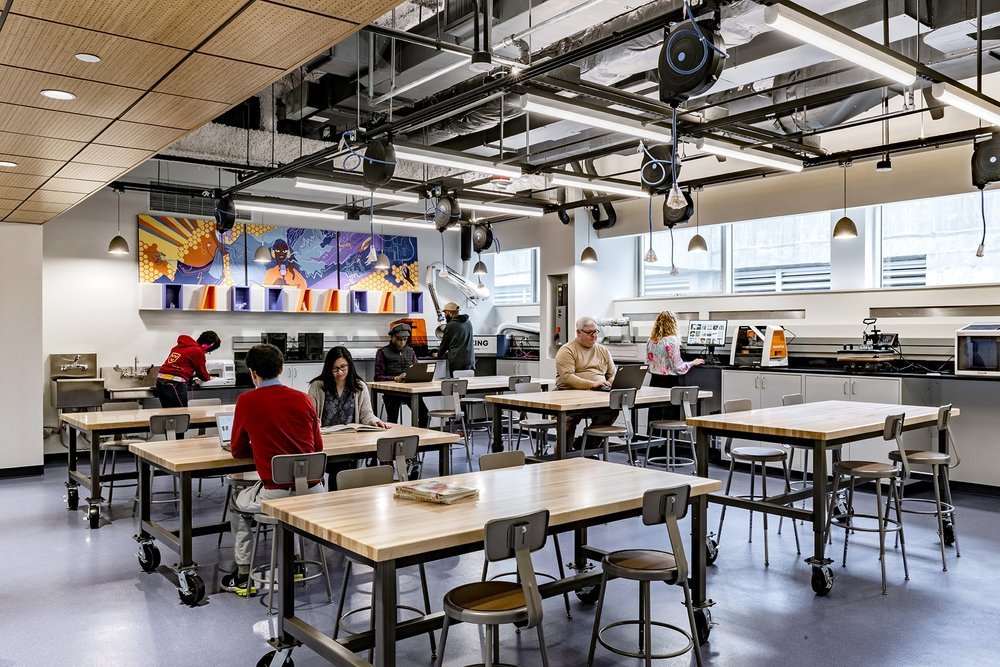
ChallengeThe City of Cambridge STEAM Initiative tasked Janos with building an inclusive ecosystem that fosters creativity, innovation, and collaboration across seven public spaces, integrating education, job training, and entrepreneurship.
Key Challenges Include:
Ensuring equitable access and participation in the CI-ME (Cambridge Innovative Maker Education) "See Me," a six-month high school to adult job training program that offers a path for cultivating innovative and entrepreneurial thinking through a suite of design, equity, and hands-on training programs across diverse demographic groups.
Managing the demand for limited space and resources in makerspaces, aiming to alleviate over-capacity issues.
Standardizing safety training and equipment operation across The Ecosystem of Arts and Making (TEAM) spaces to ensure a consistent, safe environment.
Developing a cohesive set of values and expectations for all CI-ME participants and the TEAM ecosystem.
ProcessTo address these challenges, the CI-ME program brings together learners across nine public-facing creative community centers, providing access to design, equity, and entrepreneurial training. Participants known as SAGEs (Skillful Artisans, Gifted Entrepreneurs) go through three distinct phases: classroom learning, hands-on shop training, and fabrication projects, culminating in an entrepreneurial venture or creative space management certificate. Each phase is focused on developing technical, mental, and interpersonal skills.
CI-ME Program Development: Coordinating with nine TEAM spaces, the program is designed to provide holistic, hands-on education in STEAM disciplines, focusing on entrepreneurship, creativity, and equity.
Curriculum Design: The curriculum spans three phases, from mental/emotional safety and bias awareness to hands-on training in various skills, including video production, CAD software, laser cutting, and circuits.
Program Coordination: Logistical support is provided to ensure smooth application processes, participant tracking, and outreach strategies, helping to recruit a diverse range of SAGEs and ensuring the program is aligned with community needs.
Instructor and Participant Engagement: Instructors undergo specialized training to foster effective communication and create a supportive, inclusive environment. SAGEs are mentored, trained, and guided through personal and professional development.
SolutionThe solution involves creating a robust, inclusive, and community-oriented STEAM ecosystem that empowers individuals with the skills and knowledge to innovate, collaborate, and build entrepreneurial ventures. By integrating CI-ME with TEAM, learners gain direct access to various tools, technologies, and resources. Upon completing the program, SAGEs earn certificates and are placed in positions that allow them to continue contributing to the creative community in Cambridge or launch their ventures.
Creating the TEAM Ecosystem: The coalition of nine community centers offers a vast array of resources, including technical equipment, creative spaces, and professional mentors.
Equitable Design and Inclusion: The program integrates racial and social equity principles into all aspects of the curriculum, ensuring that all participants are supported, regardless of background.
Job Training and Entrepreneurship: Participants are taught technical skills and trained in entrepreneurial thinking and project management. This empowers them to transition into various job roles or start their businesses.
SAGE Job Placement and Continuing Education: Graduates can pursue positions within the TEAM spaces, develop portfolios, or teach at community centers, continuing their professional growth.
learningsThrough the CI-ME initiative, Janos learned that successful community-driven innovation requires clear communication, strong partnerships, and ongoing support for instructors and learners. Equally important is the need for flexibility in allocating resources and how programs are structured to meet the community's diverse needs.
Flexibility and Adaptability: Tailoring the program to accommodate the varying needs of the participants, from students to adults, helps increase participation and engagement.
Community Engagement: Collaboration between various local spaces is essential to building an interconnected, resource-rich ecosystem supporting innovation and personal development.
Sustainability: To ensure the program’s longevity, continuous investment in resources and infrastructure is necessary, including maintaining the safety, maintenance, and training of equipment.
Equity as a Foundation: The importance of embedding equity at every program level—from participant recruitment to curriculum design—ensures that all learners, regardless of their background, have an equal opportunity to succeed.